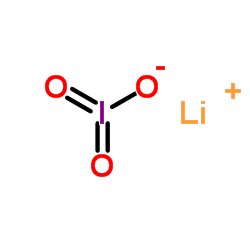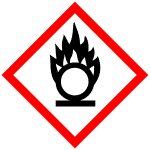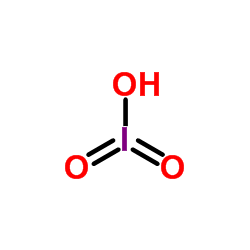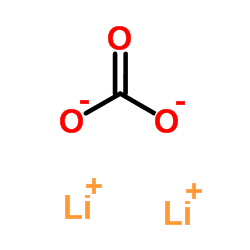Lithium iodate

Lithium iodate structure
|
Common Name | Lithium iodate | ||
|---|---|---|---|---|
| CAS Number | 13765-03-2 | Molecular Weight | 181.844 | |
| Density | 4.50(17ºC) | Boiling Point | N/A | |
| Molecular Formula | ILiO3 | Melting Point | 50-60ºC | |
| MSDS | Chinese USA | Flash Point | N/A | |
| Symbol |



GHS03, GHS07, GHS08 |
Signal Word | Danger | |
| Name | lithium,iodate |
|---|---|
| Synonym | More Synonyms |
| Density | 4.50(17ºC) |
|---|---|
| Melting Point | 50-60ºC |
| Molecular Formula | ILiO3 |
| Molecular Weight | 181.844 |
| Exact Mass | 181.905212 |
| PSA | 57.20000 |
| LogP | 0.52930 |
|
Section1. IDENTIFICATION OF THE SUBSTANCE/MIXTURE Product identifiers Product name: Lithium iodate CAS-No.: 13765-03-2 Relevant identified uses of the substance or mixture and uses advised against Identified uses: Laboratory chemicals, Manufacture of substances Section2. HAZARDS IDENTIFICATION Classification of the substance or mixture Classification according to Regulation (EC) No 1272/2008 [EU-GHS/CLP] Oxidizing solids (Category 2) Skin irritation (Category 2) Eye irritation (Category 2) Reproductive toxicity (Category 1B) Specific target organ toxicity - single exposure (Category 3) Classification according to EU Directives 67/548/EEC or 1999/45/EC May cause harm to the unborn child. Contact with combustible material may cause fire. Irritating to eyes, respiratory system and skin. Label elements Labelling according Regulation (EC) No 1272/2008 [CLP] Pictogram Signal wordDanger Hazard statement(s) H272May intensify fire; oxidiser. H315Causes skin irritation. H319Causes serious eye irritation. H335May cause respiratory irritation. H360May damage fertility or the unborn child. Precautionary statement(s) P201Obtain special instructions before use. P220Keep/Store away from clothing/ combustible materials. P261Avoid breathing dust/ fume/ gas/ mist/ vapours/ spray. P305 + P351 + P338IF IN EYES: Rinse cautiously with water for several minutes. Remove contact lenses, if present and easy to do. Continue rinsing. P308 + P313IF exposed or concerned: Get medical advice/ attention. Supplemental Hazardnone Statements According to European Directive 67/548/EEC as amended. Hazard symbol(s) R-phrase(s) R61May cause harm to the unborn child. R8Contact with combustible material may cause fire. R36/37/38Irritating to eyes, respiratory system and skin. S-phrase(s) S53Avoid exposure - obtain special instructions before use. S17Keep away from combustible material. S22Do not breathe dust. S36/37/39Wear suitable protective clothing, gloves and eye/face protection. S45In case of accident or if you feel unwell, seek medical advice immediately (show the label where possible). Restricted to professional users. Other hazards - none Section3. COMPOSITION/INFORMATION ON INGREDIENTS Substances Formula: ILiO3 Molecular Weight: 181,84 g/mol ComponentConcentration Lithiumiodat CAS-No.13765-03-2- EC-No.237-365-2 Section4. FIRST AID MEASURES Description of first aid measures General advice Consult a physician. Show this safety data sheet to the doctor in attendance. If inhaled If breathed in, move person into fresh air. If not breathing, give artificial respiration. Consult a physician. In case of skin contact Wash off with soap and plenty of water. Consult a physician. In case of eye contact Rinse thoroughly with plenty of water for at least 15 minutes and consult a physician. If swallowed Never give anything by mouth to an unconscious person. Rinse mouth with water. Consult a physician. Most important symptoms and effects, both acute and delayed Large doses of lithium ion have caused dizziness and prostration, and can cause kidney damage if sodium intake is limited. Dehydration, weight loss, dermatological effects, and thyroid disturbances have been reported. Central nervous system effects that include slurred speech, blurred vision, sensory loss, ataxia, and convulsions may occur. Diarrhea, vomiting, and neuromuscular effects such as tremor, clonus, and hyperactive reflexes may occur as a result of repeated exposure to lithium ion., Prolonged exposure to iodides may produce iodism in sensitive individuals. Symptoms of exposure include: skin rash, running nose, headache and irritation of the mucous membrane. For severe cases the skin may show pimples, boils, hives, blisters and black and blue spots. Iodides are readily diffused across the placenta. Neonatal deaths from respiratory distress secondary to goiter have been reported. Iodides have been known to cause drug-induced fevers, which are usually of short duration., To the best of our knowledge, the chemical, physical, and toxicological properties have not been thoroughly investigated. Indication of any immediate medical attention and special treatment needed no data available Section5. FIREFIGHTING MEASURES Extinguishing media Suitable extinguishing media Use water spray, alcohol-resistant foam, dry chemical or carbon dioxide. Special hazards arising from the substance or mixture Lithium oxides Advice for firefighters Wear self contained breathing apparatus for fire fighting if necessary. Further information Use water spray to cool unopened containers. Section6. ACCIDENTAL RELEASE MEASURES Personal precautions, protective equipment and emergency procedures Use personal protective equipment. Avoid dust formation. Avoid breathing vapors, mist or gas. Ensure adequate ventilation. Evacuate personnel to safe areas. Avoid breathing dust. Environmental precautions Prevent further leakage or spillage if safe to do so. Do not let product enter drains. Methods and materials for containment and cleaning up Sweep up and shovel. Contain spillage, and then collect with an electrically protected vacuum cleaner or by wet-brushing and place in container for disposal according to local regulations (see section 13). Keep in suitable, closed containers for disposal. Reference to other sections For disposal see section 13. Section7. HANDLING AND STORAGE Precautions for safe handling Avoid contact with skin and eyes. Avoid formation of dust and aerosols.Avoid exposure - obtain special instructions before use. Provide appropriate exhaust ventilation at places where dust is formed.Keep away from sources of ignition - No smoking.Keep away from heat and sources of ignition.Normal measures for preventive fire protection. Conditions for safe storage, including any incompatibilities Store in cool place. Keep container tightly closed in a dry and well-ventilated place. Specific end use(s) no data available Section8. EXPOSURE CONTROLS/PERSONAL PROTECTION Control parameters Components with workplace control parameters Exposure controls Appropriate engineering controls Handle in accordance with good industrial hygiene and safety practice. Wash hands before breaks and at the end of workday. Personal protective equipment Eye/face protection Safety glasses with side-shields conforming to EN166 Use equipment for eye protection tested and approved under appropriate government standards such as NIOSH (US) or EN 166(EU). Skin protection Handle with gloves. Gloves must be inspected prior to use. Use proper glove removal technique (without touching glove's outer surface) to avoid skin contact with this product. Dispose of contaminated gloves after use in accordance with applicable laws and good laboratory practices. Wash and dry hands. The selected protective gloves have to satisfy the specifications of EU Directive 89/686/EEC and the standard EN 374 derived from it. Body Protection Impervious clothing., The type of protective equipment must be selected according to the concentration and amount of the dangerous substance at the specific workplace. Respiratory protection Where risk assessment shows air-purifying respirators are appropriate use a full-face particle respirator type N100 (US) or type P3 (EN 143) respirator cartridges as a backup to engineering controls. If the respirator is the sole means of protection, use a full-face supplied air respirator. Use respirators and components tested and approved under appropriate government standards such as NIOSH (US) or CEN (EU). Section9. PHYSICAL AND CHEMICAL PROPERTIES Information on basic physical and chemical properties a) AppearanceForm: crystalline Colour: white b) Odourno data available c) Odour Thresholdno data available d) pHno data available e) Melting point/freezingno data available point f) Initial boiling point and no data available boiling range g) Flash pointnot applicable h) Evaporation rateno data available i) Flammability (solid, gas) no data available j) Upper/lowerno data available flammability or explosive limits k) Vapour pressureno data available l) Vapour densityno data available m) Relative densityno data available n) Water solubilityno data available o) Partition coefficient: n- no data available octanol/water p) Auto-ignitionno data available temperature q) Decompositionno data available temperature r) Viscosityno data available s) Explosive propertiesno data available t) Oxidizing propertiesThe substance or mixture is classified as oxidizing with the category 2. Other safety information no data available Section10. STABILITY AND REACTIVITY Reactivity no data available Chemical stability no data available Possibility of hazardous reactions no data available Conditions to avoid no data available Incompatible materials Strong acids, Strong reducing agents, Organic materials, Powdered metals Hazardous decomposition products Other decomposition products - no data available Section11. TOXICOLOGICAL INFORMATION Information on toxicological effects Acute toxicity no data available Inhalation: no data available Skin corrosion/irritation no data available Serious eye damage/eye irritation no data available Respiratory or skin sensitization Prolonged or repeated exposure may cause allergic reactions in certain sensitive individuals. Germ cell mutagenicity no data available Carcinogenicity IARC:No component of this product present at levels greater than or equal to 0.1% is identified as probable, possible or confirmed human carcinogen by IARC. Reproductive toxicity Presumed human reproductive toxicant Specific target organ toxicity - single exposure Inhalation - May cause respiratory irritation. Specific target organ toxicity - repeated exposure no data available Aspiration hazard no data available Potential health effects InhalationMay be harmful if inhaled. Causes respiratory tract irritation. IngestionMay be harmful if swallowed. SkinMay be harmful if absorbed through skin. Causes skin irritation. Eyes Causes serious eye irritation. Signs and Symptoms of Exposure Large doses of lithium ion have caused dizziness and prostration, and can cause kidney damage if sodium intake is limited. Dehydration, weight loss, dermatological effects, and thyroid disturbances have been reported. Central nervous system effects that include slurred speech, blurred vision, sensory loss, ataxia, and convulsions may occur. Diarrhea, vomiting, and neuromuscular effects such as tremor, clonus, and hyperactive reflexes may occur as a result of repeated exposure to lithium ion., Prolonged exposure to iodides may produce iodism in sensitive individuals. Symptoms of exposure include: skin rash, running nose, headache and irritation of the mucous membrane. For severe cases the skin may show pimples, boils, hives, blisters and black and blue spots. Iodides are readily diffused across the placenta. Neonatal deaths from respiratory distress secondary to goiter have been reported. Iodides have been known to cause drug-induced fevers, which are usually of short duration., To the best of our knowledge, the chemical, physical, and toxicological properties have not been thoroughly investigated. Additional Information RTECS: Not available Section12. ECOLOGICAL INFORMATION Toxicity no data available Persistence and degradability no data available Bioaccumulative potential no data available Mobility in soil no data available Results of PBT and vPvB assessment no data available Other adverse effects no data available Section13. DISPOSAL CONSIDERATIONS Waste treatment methods Product Burn in a chemical incinerator equipped with an afterburner and scrubber but exert extra care in igniting as this material is highly flammable. Offer surplus and non-recyclable solutions to a licensed disposal company. Contact a licensed professional waste disposal service to dispose of this material. Contaminated packaging Dispose of as unused product. Section14. TRANSPORT INFORMATION UN number ADR/RID: 1479IMDG: 1479IATA: 1479 UN proper shipping name ADR/RID: OXIDIZING SOLID, N.O.S. (Lithiumiodat) IMDG:OXIDIZING SOLID, N.O.S. (Lithiumiodat) IATA:Oxidizing solid, n.o.s. (Lithiumiodat) Transport hazard class(es) ADR/RID: 5.1IMDG: 5.1IATA: 5.1 Packaging group ADR/RID: IIIMDG: IIIATA: II Environmental hazards ADR/RID: yesIMDG Marine Pollutant: yesIATA: no Special precautions for user no data available Section15. REGULATORY INFORMATION This safety datasheet complies with the requirements of Regulation (EC) No. 1907/2006. Safety, health and environmental regulations/legislation specific for the substance or mixture no data available Chemical Safety Assessment no data available Section16. OTHER INFORMATION Further information Copyright 2012 Co. LLC. License granted to make unlimited paper copies for internal use only. The above information is believed to be correct but does not purport to be all inclusive and shall be used only as a guide. The information in this document is based on the present state of our knowledge and is applicable to the product with regard to appropriate safety precautions. It does not represent any guarantee of the properties of the product. Corporation and its Affiliates shall not be held liable for any damage resulting from handling or from contact with the above product. See and/or the reverse side of invoice or packing slip for additional terms and conditions of sale. |
| Symbol |



GHS03, GHS07, GHS08 |
|---|---|
| Signal Word | Danger |
| Hazard Statements | H272-H315-H319-H335-H360 |
| Precautionary Statements | P201-P220-P261-P305 + P351 + P338-P308 + P313 |
| Personal Protective Equipment | Eyeshields;full-face particle respirator type N100 (US);Gloves;respirator cartridge type N100 (US);type P1 (EN143) respirator filter;type P2 (EN 143) respirator cartridges;type P3 (EN 143) respirator cartridges |
| Hazard Codes | O: Oxidizing agent;T: Toxic; |
| Risk Phrases | R61 |
| Safety Phrases | S53-S17-S22-S36/37/39-S45 |
| RIDADR | UN 1479 5.1/PG 2 |
| WGK Germany | 3 |
| Packaging Group | II |
| Hazard Class | 5.1 |
|
~% 
Lithium iodate CAS#:13765-03-2 |
| Literature: Annalen der Physik (Weinheim, Germany), , vol. 44, p. 555 Annalen der Physik (Weinheim, Germany), , vol. 66, p. 83 - 83 Ann. Chim. Phys., , vol. 51, p. 137 - 137 |
|
~% 
Lithium iodate CAS#:13765-03-2 |
| Literature: Acta Chimica Academiae Scientiarum Hungaricae, , vol. 110, # 2 p. 175 - 182 |
|
Multiwalled carbon nanotubes dispersed in carminic acid for the development of catalase based biosensor for selective amperometric determination of H(2)O(2) and iodate.
Biosens. Bioelectron. 29(1) , 151-8, (2011) We report the preparation of stable dispersion of multiwalled carbon nanotubes (MWCNTs) using carminic acid (CA) as a dispersing agent. The transmission electron microscopy (TEM), scanning electron mi... |
|
|
[Correlation between ERPF and retention function on 131I-OIH renogram].
Kaku Igaku. 21(10) , 1285-92, (1984)
|
|
|
Accounting for changes in particle charge, dry mass and composition occurring during studies of single levitated particles.
J. Phys. Chem. A 116(40) , 9941-53, (2012) The most used instrument in single particle hygroscopic analysis over the past thirty years has been the electrodynamic balance (EDB). Two general assumptions are made in hygroscopic studies involving... |
| EINECS 237-365-2 |
| MFCD00016189 |
| lithium iodiate |
| LithoTab iodate |
| Lithium iodate |
| Iodic acid (HIO3),lithium salt |
| Iodic acid (HIO3),lithium salt (1:1) |


